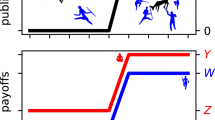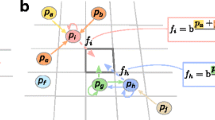Abstract
Understanding how cooperation evolves is central to explaining some core features of our biological world. Many important evolutionary events, such as the arrival of multicellularity or the origins of eusociality, are cooperative ventures between formerly solitary individuals. Explanations of the evolution of cooperation have primarily involved showing how cooperation can be maintained in the face of free-riding individuals whose success gradually undermines cooperation. In this paper I argue that there is a second, distinct, and less well explored, problem of cooperation that I call the generation of benefit. Focusing on how benefit is generated within a group poses a different problem: how is it that individuals in a group can (at least in principle) do better than those who remain solitary? I present several different ways that benefit may be generated, each with different implications for how cooperation might be initiated, how it might further evolve, and how it might interact with different ways of maintaining cooperation. I argue that in some cases of cooperation, the most important underlying “problem” of cooperation may be how to generate benefit, rather than how to reduce conflict or prevent free-riding.
Similar content being viewed by others
Notes
Skyrms (2003) explores the evolution of cooperation with the “stag hunt”, a model where risk-avoidance rather than cheating prevents the maintenance of cooperation. This work still contrasts with the focus I have in this paper.
A significant exception to this claim is the work by Peter Corning, a fact bought to my attention by an anonymous referee (see, for example, Corning (1983, 2005)). Corning emphasises the importance of understanding synergistic interactions in evolution of cooperation: “Whatever functionally significant factors are responsible in a given context for causing differential survival and reproduction” (Corning 2005, p. 71). His emphasis is similar to my own, though it is not spelt out using the distinction I make in this paper. Corning’s work also intends to marry together a great many more ideas than I explore, especially at the human end of the cooperative scale.
Referred to in Maynard-Smith and Szathmáry (1995) as a “levels of selection” problem.
At least, division of labour as it has traditionally been conceived (following Smith (1981)) is about how benefit is generated. But it is also argued that the division of reproductive labour—such as the arise of a germ/soma distinction—is a way of reducing cheating. I shall revisit this idea in section "Interplay between the two aspects" where I consider the interplay between these two aspects of cooperation.
Corning (2005, p. 73) makes a similar connection.
For a broad selection of current issues, the paper by Lehmann and Keller (2006) is followed by 15 commentaries by many of the key contributors to the field of cooperation.
The direct benefits of an action are those that accrue directly to an individual, increasing its reproductive output. Indirect benefits are those that accrue via relatedness. Thus helping a family member might provide no direct benefit, yet it may be beneficial (in an evolutionary sense), as it increases their reproductive output. Both direct and indirect benefit increase the likelihood of an individual’s traits appearing in some future generation.
Recent work suggests that the flagella perform an additional function to motility (Short et al. 2006; Solari et al. 2006). The coordinated beating of the multiple flagella enhances nutrient uptake at the surface of the sphere of cells. This is important, as the metabolic demands of the cellular group increase faster than surface area as the size of the group goes up.
There are, of course, many other reasons to explain why ants currently group together. But we are looking for isolated reasons that might explain the origin of these kinds of behaviours.
Much eukaryotic regulation is done by the complex interaction of several binding processes. These processes are combinatorial, and can create complex switches that effectively switch on as a result of some “boolean” logic on the multiple signals (Bolouri and Davidson 2002).
It should be noted that the issue of multiple mating is a complex one. A recent recent review provides 14 hypotheses (!) for this type of genetic variability (Crozier and Fjerdingstad 2001). The current consensus appears to be (very sensibly) that there may be multiple reasons for it.
Though see Leroi et al. (2003) for a spectacular exception to this—a cancer that has escaped its original organism (a dog) and is transmitted by sexual contact.
References
Anderson C, Franks NR (2001) Teams in animal societies. Behav Ecol 12(5):534–540
Anderson C, Franks NR, McShea DW (2001) The complexity and hierarchical structure of tasks in insect societies. Anim Behav 62:643–651
Ariew A (2003) Ernst Mayr’s “ultimate/proximate” distinction reconsidered and reconstructed. Biol Philos 18:553–565
Arthur W (2004) Biased embryos and evolution. Cambridge University Press, Cambridge, New York
Bingham PM (2000) Human evolution and human history: a complete theory. Evol Anthropol 9(6):248–257
Bolouri H, Davidson EH (2002) Modeling transcriptional regulatory networks. BioEssays 24(12):1118–1129
Bonner JT (1988) The evolution of complexity by means of natural selection. Princeton University Press, Princeton, NJ
Boyd R, Richerson PJ (1992) Punishment allows the evolution of cooperation (or anything else) in sizeable groups. Ethol Sociobiol 13:171–195
Buss LW (1987) The evolution of individuality. Princeton University Press, Princeton, NJ
Caro TM (2005) Antipredator defenses in birds and mammals. University of Chicago Press
Corning PA (1983) The synergism hypothesis: a theory of progressive evolution. Mcgraw-Hill, New York
Corning PA (2005) Holistic darwinism: synergy, cybernetics, and the bioeconomics of evolution. University of Chicago Press
Craig CL (2003) Spiderwebs and silk. Oxford University Press, New York
Crozier RH, Fjerdingstad EJ (2001) Polyandry in social Hymenoptera—disunity in diversity? Ann Zoo Fenn 38(3):267–285
Dennett DC (1995) Darwin’s dangerous idea: evolution and the meanings of life. Simon & Schuster, New York
Dugatkin LA (1997) Cooperation among animals: an evolutionary perspective. Oxford University Press
Duncan L, Nishii I, Howard A, Kirk D, Miller SM (2006) Orthologs and paralogs of regA, a master cell-type regulatory gene in Volvox carteri. Curr Genet 50(1):61–72
Francis RC (1990) Causes, proximate and ultimate. Biol Philos 5(4):401–415
Franks NR, Partridge LW (1994) Lanchester’s theory of combat, self-organization, and the evolution of army ants and cellular societies. In: Real LA (ed) Behavioural mechanisms in evolutionary ecology. University of Chicago Press
Franks NR, Sendova-Franks AB, Anderson C (2001) Division of labour within teams of new world and old world army ants. Anim Behav 62:653–642
Frisch Kv (1966) The dancing bees: an account of the life and senses of the honey bee, 2nd ed. Methuen, London
Gompel N, Prud’homme B, Wittkopp PJ, Kassner VA, Carroll SB (2005) Chance caught on the wing: cis-regulatory evolution and the origin of pigment patterns in Drosophila. Nature 433(7025):481–487
Graham S, Myerscough M, Jones J, Oldroyd B (2006) Modelling the role of intracolonial genetic diversity on regulation of brood temperature in honey bee (Apis mellifera L.) colonies. Insectes Soc 53(2):226–232
Hitchcock C, Woodward J (2003) Explanatory generalizations, part 2, plumbing explanatory depth. Nous 37(2):181–199
Jones JC, Myerscough MR, Graham S, Oldroyd BP (2004) Honey bee nest thermoregulation: diversity promotes stability. Science 305(5682):402–404
Kerr B, Godfrey-Smith P (2002) On the relations between individualist and multi-level models of selection in structured populations. Biol Philos 17(4):447–517
Kirk DL (2001) Germ-soma differentiation in Volvox. Develop Biol 238(2):213–223
Kirk DL (2003) Seeking the ultimate and proximate causes of Volvox multicellularity and cellular differentiation. Integr Comp Biol 43(2):247–253
Kirschner M, Gerhart J (1998) Evolvability. Proc Nat Acad Sci 95:8420–8427
Kirschner M, Gerhart J (2005) The plausibility of life: resolving Darwin’s dilemma. Yale University Press, New Haven
Krause J, Ruxton GD (2002) Living in groups, oxford series in ecology and evolution. Oxford University Press, Oxford
LaBarbera M (1990) Principles of design of fluid transport systems in zoology. Science 249(4972):992
Lehmann L, Keller L (2006) The evolution of cooperation and altruism—a general framework and a classification of models. J Evol Biol 19(5):1365–1376
Leroi AM, Koufopanou V, Burt A (2003) Cancer selection. Nat Rev Cancer 3(3):226–231
Maynard-Smith J, Szathmáry E (1995) The major transitions in evolution. W.H. Freeman Spektrum, Oxford, New York
Maynard-Smith J, Harper D (2003) Animal signals, oxford series in ecology and evolution. Oxford University Press
Mayr E (1961) Cause and effect in biology. Science 134:1501–1506
McGlynn TP (2000) Do Lanchester’s laws of combat describe competition in ants? Behav Ecol 11(6):686–690
Michod RE (1999) Darwinian dynamics: evolutionary transitions in fitness and individuality. Princeton University Press, Princeton, NJ
Michod RE, Roze D (1999) Cooperation and conflict in the evolution of individuality. III. Transitions in the unit of fitness. In: Nehaniv CL (ed) Mathematical and computational biology: computational morphogenesis, hierarchical complexity, and digital evolution, vol 26. American Mathematical Society, Providence, RI
Michod RE, Herron MD (2006) Cooperation and conflict during evolutionary transitions in individuality. J Evol Biol 19(5):1406–1409
Myerscough MR, Oldroyd BP (2004) Simulation models of the role of genetic variability in social insect task allocation. Insectes Soc 51(2):146–152
Naug D, Wenzel J (2006) Constraints on foraging success due to resource ecology limit colony productivity in social insects. Behav Ecol Sociobiol 60:62–68
Nedelcu AM, Michod RE (2006) The evolutionary origin of an altruistic gene. Mole Biol Evol 23(8):1460–1464
Ofek H (2001) Second nature: economic origins of human evolution. Cambridge University Press, Cambridge, England, New York
Queller DC (2000) Relatedness and the fraternal major transitions. Philos Transac Roy Soc Lond Ser B: Biol Sci 355(1403):1647–1655
Queller DC, Strassmann JE (1998) Kin selection and social insects. Bioscience 48(3):165–175
Sachs JL, Mueller UG, Wilcox TP, Bull JJ (2004) The evolution of cooperation. Quar Rev Biol 79(2):135–160
Schlichting CD, Pigliucci M (1998) Phenotypic evolution: a reaction norm perspective. Sinauer Associates, Sunderland, MA
Seeley TD (1995) The wisdom of the hive: the social physiology of honey bee colonies. Harvard University Press, Cambridge, Mass
Short MB, Solari CA, Ganguly S, Powers TR, Kessler JO, Goldstein RE (2006) Flows driven by flagella of multicellular organisms enhance long-range molecular transport. Proc Nat Acad Sci 103(22):8315
Skyrms B (2003) The stag hunt and the evolution of social structure. Cambridge University Press
Smith A (1981) An inquiry into the nature and causes of the wealth of nations. Liberty Press, Indianapolis, Indiana
Sober E (1984) The nature of selection: evolutionary theory in philosophical focus. Mit Press, Cambridge, Mass
Sober E, Wilson DS (1998) Unto others: the evolution and psychology of unselfish behavior. Harvard University Press, Cambridge, Mass
Solari CA, Ganguly S, Kessler JO, Michod RE, Goldstein RE (2006) Multicellularity and the functional interdependence of motility and molecular transport. Proc Nat Acad Sci 103(5):1353–1358
Sterelny K (2003) Thought in a hostile world: the evolution of human cognition. Blackwell, Malden, MA
Stern DL, Foster WA (1997) The evolution of sociality in aphids: a clone’s-eye view. In: Choe JC, Crespi BJ (eds) Social behaviour and insects and arachnids. Cambridge University Press
Tinbergen N (1952) “Derived” activities; their causation, biological significance, origin, and emancipation during evolution. Quar Rev Biol 27(1):1–32
Tinbergen N (1963) On aims and methods of ethology. Z Tierpsychol 20:410–433
West-Eberhard MJ (2003) Developmental plasticity and evolution. Oxford University Press, Oxford
Wilkinson G (1984) Reciprocal food sharing in the vampire bat. Nature 308(5955):181–184
Woodward J, Hitchcock C (2003) Explanatory generalization, part 1, a counterfactual account. Nous 37(1):1–24
Wray GA (2006) Evolution: spot on (and off). Nature 440(7087):1001–1002
Acknowledgements
Peter Godfrey-Smith, Kim Sterelny, and an anonymous reviewer provided guidance and many helpful suggestions on earlier drafts.
Author information
Authors and Affiliations
Corresponding author
Rights and permissions
About this article
Cite this article
Calcott, B. The other cooperation problem: generating benefit. Biol Philos 23, 179–203 (2008). https://doi.org/10.1007/s10539-007-9095-5
Received:
Accepted:
Published:
Issue Date:
DOI: https://doi.org/10.1007/s10539-007-9095-5




